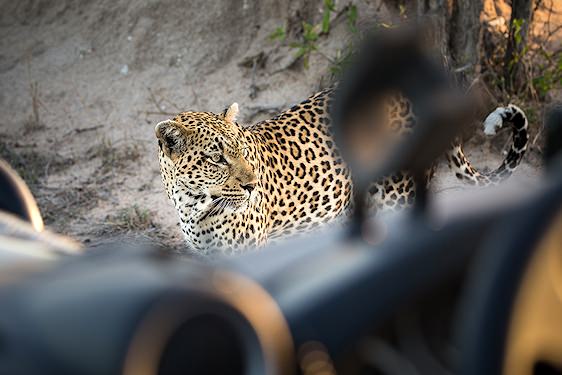- Home
- >
- African Travel
- >
- South Africa
- >
- National Parks
- >
- Kruger National Park
- >
- Mammals
- >
- White-tailed Mongoose
Description
This striking nocturnal carnivore is named for its long, bushy white tail, which contrasts with a coarse gray coat and darker limbs. The body is sturdy with a somewhat elongated muzzle and strong claws for digging. As the largest mongoose species, adults typically weigh 2.9–4.2 kg, with males slightly heavier than females and a head-and-body length of 53–71 cm.

White-tailed mongoose are widespread in sub-Saharan Africa. Within Southern Africa, they occur from northern Namibia and Botswana through Zimbabwe and into northeastern South Africa, including parts of KwaZulu-Natal. They are absent from true desert such as the Namib Desert and much of the Cape, favoring warmer savanna and woodland mosaics where cover and prey are available.

Status
The white-tailed mongoose benefits from a broad African distribution and presence in many protected landscapes. It is currently listed as Least Concern, although local pressures—habitat alteration, persecution near poultry, and road mortality—can affect some populations. Night-active habits and low detectability mean numbers are seldom quantified, but the overall trend is considered stable where suitable habitat persists.

Habitat
White-tailed mongoose use a variety of warm, well-drained habitats, including savanna, open woodland, and grassy ecotones with scattered shrubs or termite mounds for cover. They generally avoid humid forests, waterlogged areas, and true desert. In Kruger National Park, they favor mixed woodland close to open patches, tracks, and drainage lines where invertebrate prey and small vertebrates are abundant at night.

Social Organization
Social structure is primarily solitary. Adults maintain overlapping home ranges, with limited tolerance outside of courtship and rearing. Territorial boundaries are communicated by scent marking from anal glands and cheek rubbing at conspicuous objects along paths and latrines. A minority of records show temporary associations, but most activity—resting by day in burrows and foraging by night—occurs alone.
Finest Safari Areas in Africa for Encountering White-tailed Mongoose
We recommend the following National Parks and Private Reserves for the best chances of spotting the white-tailed mongoose on safari game drives and bush walks.

Social Behavior
While foraging, white-tailed mongoose often travel in a loose zigzag, pausing to listen and sniff before digging out insects or extracting small prey from under stones and debris. Soft mutters and low grunts may accompany close-range feeding. Individuals may circuit their entire home range over several nights, concentrating activity where prey is clumped after rain.

Reproduction
Breeding behavior is poorly documented because activity peaks at night and encounters are brief. Observations indicate multiple short copulations during courtship, with the female typically ending each bout. Mating often occurs in the dry season so that 1–3 young are born in the rains, when food is more abundant. Most evidence suggests a single breeding period annually.

Anti-Predator Behavior
When threatened, a white-tailed mongoose often freezes to assess risk, then dashes for cover. If cornered, it raises the hair on back and tail to appear larger, stamps, and may deliver a foul-smelling burst from anal glands as a deterrent. Bites and swats with strong foreclaws provide last-resort defense against small carnivores and unleashed dogs.












